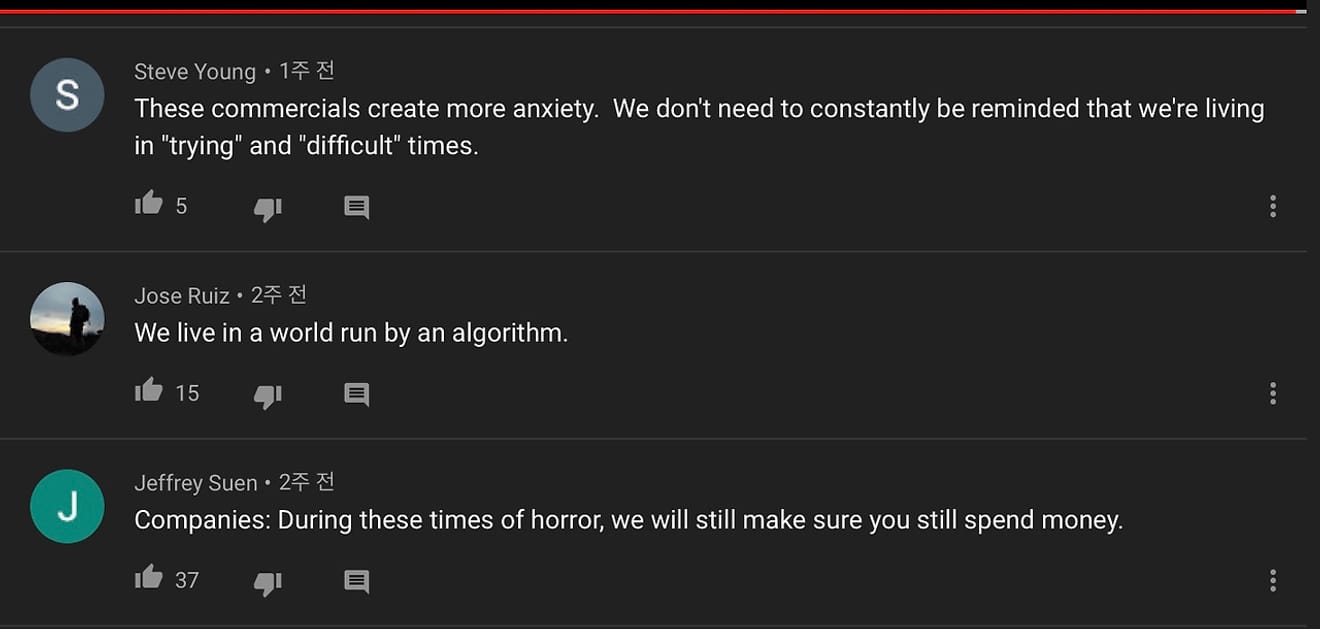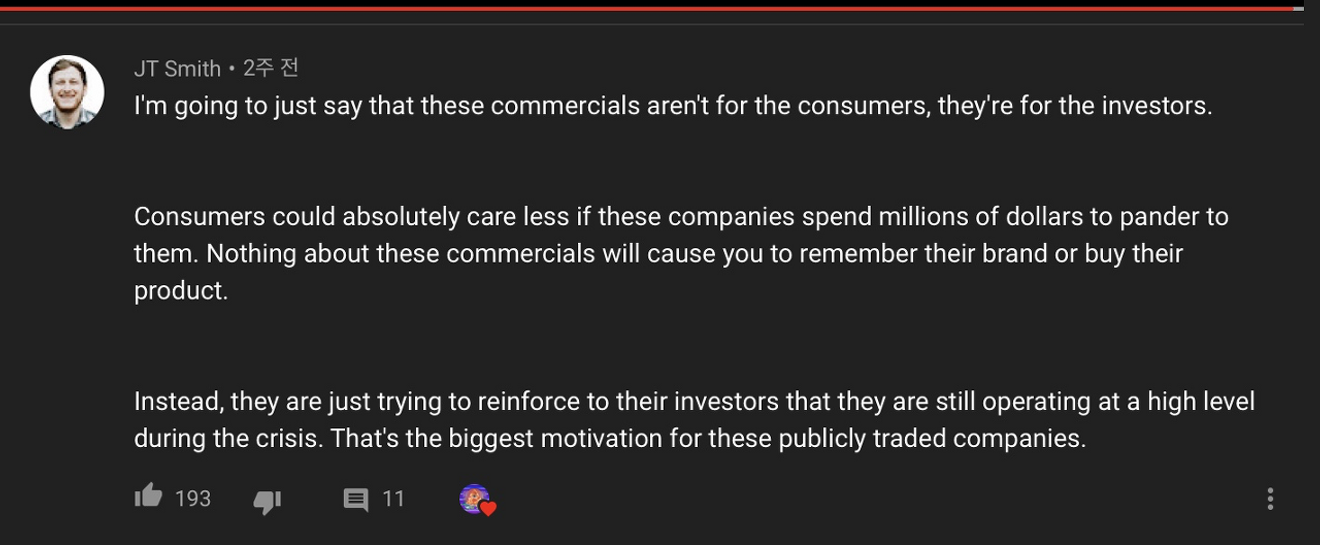Subject
- #Corporations After COVID-19
- #Influencer and Brand Relationships
- #Corporate Response to Anxiety
- #Corporate Advertising Response
- #Corporate Intent vs. Customer Response
Created: 2024-04-29
Created: 2024-04-29 18:03
Regarding the questions that companies need after the COVID-19 pandemic
First, let's check out the video below.
Every COVID-19 commercial is exactly the same
It is said that this is a video that compiles dozens of commercials made by companies during the COVID-19 pandemic.
And the repeatedly used expressive elements found within it are as follows.
At first glance, one might conclude that the ideas behind the commercials are all similar.
However, looking at the comments reveals various perspectives on corporate advertising that have existed until now.
Most notably, anger and discomfort are observed.



Among these, there are comments expressing the regret of someone in the marketing field toward the related industry,

In fact, there are opinions that such advertisements were not made for consumers but for the investors of the companies.

In addition to this, there's even a comment from someone who watched the video for reference when writing the copywriting for an advertisement to be included in a local hospital that needs to be delivered by tomorrow.
Imagine a situation where a former colleague who works for a large brand company introduces a junior who runs a small advertising company to you.
Throughout dinner, the man in front of you makes a neat and clean impression, and with kind words, he says he wants to get closer to you, but your heart is not at ease. This is because the background and circumstances that led to today's dinner gathering, and each individual's purpose within it, are all laid bare.
And empathy that reveals intent reveals its limitations in relationships sooner than expected. Naver's Children's Encyclopedia defines intent as the determination to carry out specific actions to achieve a certain goal when the right opportunity arises.The intent of a company's inherent purpose of generating profit, which cannot be hidden even with sincere music and warm smiles in the advertisement above. Aren't people responding to this intent first?
Of course, the reason for the existence of a company is to generate profits, so it is natural for its inherent intent to be upheld. However, I wanted to point out that even with the same intent, there is a difference in where they try to establish a point of contact with customers.
A few years ago, when I attended a conference at an advertising festival as a speaker, I provided the following example related to the above. It's about the difference between 'empathy' and 'compassion' as spoken by the Dalai Lama, the spiritual leader of Tibet.
"When we're walking down the road and see someone crushed by a large stone, thinking, 'Oh, that must hurt so much' is 'empathy.' And not stopping there, but going further to get a lever to remove the rock from their chest, or going around and shouting to others, 'Someone is crushed here, please help!' and seeking help, that's called compassion."
And the subsequent question, "Isn't that part of CSR (Corporate Social Responsibility)? Shouldn't it be discussed from a promotional perspective rather than relating to advertising or services?"
Actually, I empathize with this part, the company's perspective of viewing people's suffering as just social responsibility.
And for the same reason, I understand the reactions of those who initially saw the advertisement. It's because it's quite a natural result of mutual interaction for a company to view people's suffering as an observer, and for customers to view the company as a subject that only desires their consumption.
In 2015, P&G collaborated with SK-II and Google to launch Beauty Bound Asia, a tournament event to find the second Michelle Phan (the first-generation beauty YouTuber) across 11 Asian cities. At the time, as a creative director responsible for global content at the advertising agency I worked for, I spent several months on-site during the event.
While continuously observing interviews with famous beauty creators who participated as judges at the time, as well as the comments on the content of the channels they operated, I came to understand the reason why they grew into influencers and gained recognition. It was as follows.
'They experience the worries I have beforehand, take the initiative to directly confirm those concerns, and provide information about them.'
They started from their own concerns as consumers and gradually attracted others with the same worries. Viewers of the video content said they felt grateful, and the brands and products launched by these beauty creators naturally created situations where viewers directly transformed into consumers. (Example: Krave Beauty by Liah Yoo) https://kravebeauty.co.kr/company/location.html
Anthony Fauci, director of the National Institute of Allergy and Infectious Diseases (NIAID), said, “It's not us who determines the time, it's the virus that determines the time.” The situation is still ongoing, and even after stabilization, it's difficult to predict when we might face another unfamiliar and daunting situation caused by a novel virus like this one again.
Some have lost family members or jobs, while others say that nothing much has changed, just a few months of halted income and consumption. Similarly, some companies have gone bankrupt, while others have experienced greater growth than before. Like the 2008 financial crisis, the consumption reduction that began with lockdowns and the resulting changes stemming not from clear external factors but from the real economy, are revealed in a patchy and uneven manner that makes it ambiguous to say everyone has suffered immediate damage. This suggests that for businesses, there's a high likelihood that long-term market forecasts and strategic planning will become less reliable.
Those close to me worried about their inability to do anything during this period, and some experienced the limitations of their own abilities to make a living as individuals. This is connected to questions about themselves, their roles towards their families, and the meaning of the existence of family and friends around them. Perhaps these questions, born after experiencing the limitations of their previous selves, leave behind scars that might change our self-perception and behavior in ways we cannot predict.
In other words,It's difficult to clearly define current anxieties.
However, we can consider questions aimed at understanding these anxieties and finding a starting point from them.
Hwahae (화해), a platform providing information on cosmetics, recently recorded over 10 billion won in transactions. While I understand there are controversies surrounding their chemical ingredient analysis criteria, it seems clear why this company has been targeted by existing industries and why consumers have chosen them.
The 'information asymmetry' regarding chemical ingredient products we use daily. The vague anxiety arising from this. The desire to become beautiful as a woman and the anxiety related to health for myself and my child as a prospective mother clearly seem to have given meaning to Hwahae's service and existence.
What is the essence of our business? What are the anxieties our customers experience in this situation, and how can our services and products solve them?
The above questions may not be entirely accurate. However, it seems clear that the marketing department is not the place where empty, unrelatable empathy similar to the company's message in the advertisement shared initially is created and repeated in a futile manner. Perhaps these are questions that need to be asked and initiated during the R&D phase where services and products are planned and customer realities are investigated.
Comments0